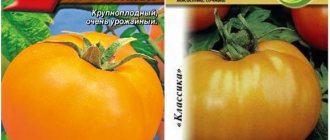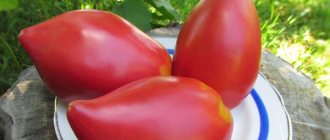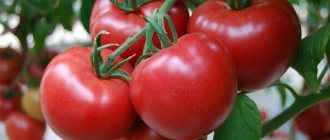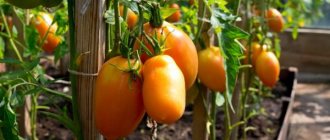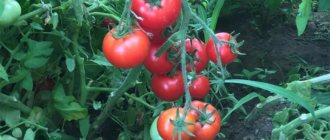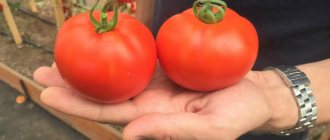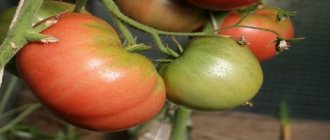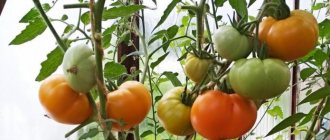Tomato Giant Novikova: variety description
| Variety name | Giant Novikova |
| general description | Mid-season indeterminate variety |
| Originator | Russia |
| Ripening period | 105-110 days |
| Form | Round, slightly flattened |
| Color | Maltnovy |
| Average weight of tomatoes | 500-900 grams |
| Application | Universal |
| Productivity of the variety | 15-20 kg per square meter |
| Features of cultivation | Requires supports and ties |
| Disease resistance | Resistant to major diseases |
This is a mid-season variety; from the moment you plant the seedlings until the fruits fully ripen, 110-120 days will pass.
The plant is of an indeterminate, standard type. It grows equally well both in unprotected soil and in greenhouse shelters. The plant grows to a large size of more than 2 meters. Has complex resistance to diseases.
Tomatoes, once fully ripe, become bright crimson in color. Round in shape, slightly flattened, with a green base at the stalk, with deep ribbing. Very large 500-700 g, the fruits of the first harvest can reach 700-900 g. The fruit is multi-chambered, dry matter content is about 5%.
The taste is wonderful, sugary, sweet, juicy. Collected fruits are poorly stored; it is better not to keep them for a long time, but to process them or eat them fresh.
You can compare the weight of tomatoes with others in the table below:
| Variety name | Fruit weight |
| Giant Novikova | 500-900 grams |
| Diva | 120 grams |
| Yamal | 110-115 grams |
| The Golden Fleece | 85-100 grams |
| Golden heart | 100-200 grams |
| Stolypin | 90-120 grams |
| Raspberry ringing | 150 grams |
| Caspar | 80-120 grams |
| Explosion | 120-260 grams |
| Verlioka | 80-100 grams |
| Fatima | 300-400 grams |
Planting tomatoes
Tomato can be grown in a greenhouse and in open ground
Tomatoes of the Gigant Novikova variety can be cultivated outdoors, under film covering and in greenhouses. Gardeners include the following basic planting rules:
- Seedlings begin to be prepared in March - for this, tomato seeds are sown in special vegetable boxes;
- They begin to plant seedlings when 1-2 leaves appear on the plant;
- if the gardener grows tomatoes under film, then it is better to plant in mid-May, if it is open ground - the first days of June: at the age of 60-65 days, the first leaves appear on the plant bush;
- the landing scheme should look like this: 0.6x0.5 m;
- Be sure to tie up the plant and form a bush.
Characteristics
“Giant Novikova” was bred a long time ago in the USSR through amateur selection; it received registration as a variety for greenhouses and open ground in 1990. Since then, it has been extremely popular among gardeners due to its huge tasty fruits and excellent productivity. With such properties, he will remain among the leaders for a long time.
Tomatoes of this variety are best grown in the southern regions if done in open ground. Under film it gives good results in the middle band.
This does not significantly affect the yield and morbidity of the plant. In more northern regions, these tomatoes are cultivated only in heated greenhouses.
These tomatoes are not suitable for whole-fruit canning due to the large size of the fruits, but you can make barrel pickles. “Gigant Novikova” is very good fresh and goes well with other vegetables. Juices, purees and pastes are very good due to the high content of sugars and vitamins.
This variety is a giant and its yield is very high. Under good conditions, you can collect 6-9 kg from each bush. With a recommended planting density of 3 plants per square meter. m comes out to 15-20 kg. This is an excellent indicator, especially for such a tall bush.
You can compare this indicator with other varieties in the table below:
| Variety name | Productivity |
| Giant Novikova | 15-20 kg per square meter |
| Grandma's gift | up to 6 kg per square meter |
| American ribbed | 5.5 kg per bush |
| De Barao the Giant | 20-22 kg per bush |
| King of the Market | 10-12 kg per square meter |
| Kostroma | up to 5 kg per bush |
| The president | 7-9 kg per square meter |
| Summer resident | 4 kg per bush |
| Nastenka | 10-12 kg per square meter |
| Dubrava | 2 kg per bush |
| Dad | 6 kg per bush |
How to grow seedlings correctly
Residents of the South do not grow Pink or Orange Giant tomato seedlings. They plant the seeds directly into the ground. Those who live in the Central zone and to the north cannot do without growing seedlings.
Plant Siberian pink giant tomato seeds not in a common box, but in separate peat cups. This is done in order to extend the ripening time of future fruits.
Practice shows that there is no point in growing a lot of seedlings, since Pink Giant tomatoes are not planted in large quantities due to their unsuitability for canning. 8 bushes are enough for a family, no more. That is, you will need the same number of cups for seedlings. They won't take up much space.
Sow store-bought seeds immediately, but it is advisable to treat your own seeds before planting. That is, disinfect them in a weak solution of manganese and hold them for a quarter of an hour in a solution of kornevit.
Place three seeds in one glass. In this case, you will have the opportunity to choose the strongest sprout. You will make your choice after at least two leaves have formed on each of the three sprouts. After this, leave the strongest of them for further growth, and destroy the two weak shoots.
Next, you just have to monitor the soil moisture in the cup and the air temperature in the room. It should not fall below 20 degrees. It doesn’t hurt to additionally illuminate the seedlings with a neon lamp. It is very important to fertilize the soil in cups with complex liquid mineral fertilizers every two weeks.
Harden off the seedlings two weeks before planting. To do this, take the cups out into the open air every day, increasing the time the sprouts stay there every day.
In the last days before planting, leave the seedlings outdoors for a full day. You cannot take seedlings outside when it is raining or strong winds are blowing. You should also not do this if the outside temperature is 15 degrees or less.
Hardening off the seedlings is very important, as it ensures that the Pink Giant or Sugar Giant tomatoes can safely tolerate night air temperatures of up to +10 degrees.
sovusadba.ru
Photo
See below: Giant Novikova tomato photo
Read more on our website: What diseases most often threaten tomatoes in greenhouses and how to fight them? Which varieties are resistant to late blight, what kind of disease is it and how to protect yourself from it? What are the dangers of Alternaria, Fusarium, Verticillium and which varieties are not susceptible to these scourges?
Features of caring for tomato crops
Irrigation rates
The first time the plant is watered immediately after planting in the ground, and very abundantly. Then they don't bother him for two or three days. All subsequent waterings are carried out at intervals of 3-4 days (adjustments are made depending on weather conditions). While the bush is young, 2-3 liters are enough for it; An adult plant needs at least 10 liters. The water should be warm.
Did you know? In 1776, when the northern colonies of England were actively fighting for their independence, George Washington's cook decided to poison him. He prepared a magnificent roast and garnished it generously with tomatoes, seriously believing that this vegetable was poisonous (in those days this was considered a well-known fact). Being completely confident in the outcome of the matter, he even wrote a corresponding report to the commander of the English royal troops.
Top dressing
During the entire growing season, the crop must be fed three times:
- The first time fertilizer is applied a week and a half after planting the seedlings in a permanent place. Nitrogen mixtures or organics with a high nitrogen content are used.
- The second feeding is carried out at the beginning of the flowering period. Superphosphates and potassium monophosphate are added. The dosage is calculated according to the instructions given on the package.
- The last time the bush is nourished is when the ovary appears on it. It is advisable to use nutrient mixtures to increase yield.
We invite you to familiarize yourself with: The best varieties of pickling tomatoes
Since the fruits of the Giant Novikov are very large, it is necessary to normalize the ovary. It is recommended to leave 3-4 ovaries on the lower hands. The lower foliage covering the stem below the first cluster is also removed. This will reduce the likelihood of illness.
The formation of the bush is carried out in 2-3 stems, but there is no need to rush to pinch all the shoots. The variety is characterized by a long fruiting period, so it is necessary to leave room for the formation of late ovaries.
The bushes are tall, so they definitely need staking.
Weeding the soil
Loosening and weeding of the soil is carried out along with watering. Only the thin top layer is fluffed up so that a crust does not form, preventing air exchange.
If the soil is very waterlogged and loosening is not carried out in a timely manner, then the plant may be damaged by root rot. If a problem is detected, the number of waterings is reduced, the soil is loosened generously and raked away from the bushes. Peat mixed with sand and fine sawdust is poured in its place.
If tomato beds are located close to potato beds, the Colorado potato beetle can be found on them. To destroy it, the insecticide “Prestige” is used.
Did you know? Tomatoes are the most popular vegetable crop in the United States. It grows on 93% of the total number of private gardens.
Features of cultivation
The main feature of the “Giant Novikov” species is its large fruit. Also, many note the high resistance to diseases, the large size of the plant and the excellent taste of the fruit.
The trunk of the bush must be tied up, and the branches must be strengthened with supports; this will save the plant from breaking off the branches. It should be formed into two or three stems, usually three in open ground. Novikova's tomato definitely needs feeding 5-6 times per season.
Read useful articles about fertilizers for tomatoes:
- Organic, mineral, phosphorus, complex and ready-made fertilizers for seedlings and the TOP best.
- Yeast, iodine, ammonia, hydrogen peroxide, ash, boric acid.
- What is foliar feeding and when picking, how to carry it out.
Pros and cons of the variety
Experts include the following main advantages of the variety:
- excellent taste;
- large fruits (with good care, the weight of one tomato can reach 1.2-1.4 kg);
- high resistance to most diseases;
- tolerates short periods of drought.
The variety has no particular disadvantages, but the following should be noted:
- the harvested crop is not stored for long;
- “picky” variety to the composition of the soil;
- not the highest yield for such a large-fruited variety.
1001sort.ru fermoved.ru
Diseases and pests
The Giant Novikova tomato has complex resistance to fungal diseases. The only thing to be wary of is diseases associated with improper care.
To avoid such difficulties when growing, you need to regularly ventilate the room where your tomatoes are growing and follow the watering and lighting regime.
The plant also often suffers from root rot, which is combated by loosening and reducing watering. The soil around the plant is raked and a mixture of peat, sand and fine sawdust is added instead.
Among the harmful insects it can be affected by the potato bollworm, they fight against it by loosening, removing and destroying affected fruits and plants.
In the southern regions, the Colorado potato beetle can harm this species, especially in the southern regions; the “Prestige” product is successfully used against it.
Among the pests that are most capable of causing harm in greenhouses are melon aphids and spider mites; the drug “Bison” is also used against them.
Like many other types of tomatoes, they can be attacked by slugs; they are collected by hand, and the ground around the plant is sprinkled with coarse sand and lime.
As follows from our review, this is a variety for gardeners with some experience; beginners should choose a simpler tomato. But you shouldn’t give up growing it on your plot; with experience, everything will work out. Good luck to you and have a delicious harvest.
Care
Tall bushes need pinching and staking. They are formed into 1-2 stems, removing side shoots and pinching off the growing point.
The lower leaves are regularly cut off (2-3 pieces at a time) so as not to thicken or shade the plantings. Since the fruits grow very large, it is necessary to tie up not only the stems, but also the fruit clusters. (It has been noticed that when a branch is broken, the set fruits cannot ripen.)
The bed is watered once every 10 days, strictly at the root, with warm water (in hot summers, more often - once a week).
Alternatively, you can install drip irrigation.
To avoid late blight and rot, the greenhouse must be regularly ventilated. After watering, the soil is loosened, and as weeds appear, they are weeded. The beds can be mulched with dry grass or peat, which will retain moisture in the soil and make maintenance much easier.
Feeding
Tall varieties with large fruits are very fond of feeding. They need to be done every 2 weeks. It is better to alternate organic fertilizers with mineral complexes: the former ensure soil fertility, and the latter nourish the root system.
Tomato variety GIANT NOVIKOVA
Tomato Giant Novikova. Brief overview, description of characteristics, where to buy solanum lycopersicum seeds
Variety - “GIANT NOVIKOVA”. Tomatoes from Fedor.
As an emergency remedy, in case of a lack of minerals, foliar treatment is carried out on the leaves.
Useful video
In the table below you will find links to tomato varieties with different ripening periods:
| Early ripening | Mid-late | Mid-early |
| Pink fleshy | Yellow banana | Pink King F1 |
| Ob domes | Titanium | Babushkin |
| King of the Early | Slot F1 | Cardinal |
| Red Dome | gold fish | Siberian miracle |
| Soyuz 8 | Raspberry miracle | Bear Paw |
| Red icicle | De Barao red | Bells of Russia |
| Honey cream | De Barao black | Lev Tolstoy |
If you find an error, please select a piece of text and press Ctrl+Enter.
Advantages of the variety
Salad tomatoes vary in color, they are sweet in taste, with fleshy pulp. The characteristics and description of the variety of classic giant tomatoes are associated with resistance to cracking and high temperature. To experience the full flavor palette of tomatoes, it is recommended to plant all 4 color varieties.
Description of fruits:
- The pulp of the fruit is sugary, like that of a watermelon, grainy at the break, juicy, melts in the mouth.
- Red tomatoes contain record amounts of lycopene.
- Pink tomatoes have a rich, sweet taste.
- The orange and yellow fruits, which have a rich, piquant taste, contain carotene.
The Ural Giant variety attracts vegetable growers with its high adaptability to weather conditions and microclimate. Plants have ecological plasticity, so it is proposed to grow the crop in any region where it is possible to cultivate the soil.
The variety's resistance to low temperatures allows it to be grown in open ground in cold regions of the country. At the same time, the adaptation of the crop to elevated temperature conditions allows the variety to be grown in hot greenhouses and in the open air of the southern part of Russia.
The Ural giant is characterized by medium fruiting periods, because the formation of large tomatoes is associated with a lot of time. Bushes with unlimited growth potentially provide the plant with high productivity.
During the growing season, a powerful trunk is formed; the plant reaches a height of 1.5-2 m. On the bush there is a constant desire to form and develop new flower stalks. On 1 cluster, 3-5 ovaries are formed, from which fruits of a round shape with slight ribbing develop.
When cut horizontally, many chambers with seeds are observed. Tomatoes of the Ural Giant variety reach a weight of 800 g. Salad-type tomatoes are not intended for long-term storage, so it is recommended to process part of the harvest in time into tomato paste and lecho.
Among the advantages are the following:
- If you care for the bushes correctly, then up to 15 kg of vegetables will be harvested per square meter during the season.
- Since the bushes are mature, up to 5 ovaries can form on one brush. This allows for very efficient use of space.
- The fruits have a good aroma and taste.
- Although the vegetables are large, they crack extremely rarely.
- They tolerate both extreme heat and cold well.
Tomatoes: advantages and disadvantages
The tomato variety “Giant Novikova” has the following positive qualities:
- Excellent taste characteristics;
- Large fruit;
- High productivity;
- Immunity to major nightshade diseases;
- Drought resistance;
- Resistant to mechanical damage;
- Possibility of transportation.
Among the disadvantages of the variety are:
- Rapid spoilage of tomato fruits;
- Increased demands on fertilizers applied to the soil.
